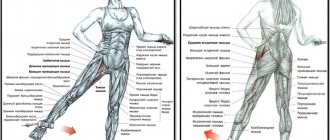The popularity of eccentric training began to increase in the early 21st century. Until the end of the last millennium, this type of training was practiced much less frequently. This is due to the fact that athletes suffer the most injuries during eccentric loads. Today, eccentric training is used not only as an effective way to build muscle mass, but also in rehabilitation or injury prevention.
Initially, interest in eccentric loads was aroused in the 70s of the 20th century by articles by Arthur Jones published in popular sports magazines. There Jones described the tactics of eccentric training, and later even developed special simulators.
Eccentric training - what is it?
Conventionally, all exercises are divided into two stages - concentric and eccentric. Both stages involve muscle contraction, only at the concentric stage the muscle shortens, and at the eccentric stage the muscle lengthens.
The simplest example is an exercise with a barbell - when lifting the barbell, a concentric contraction occurs, and when lowering it, an eccentric contraction occurs.
Both stages are designed to provoke an increase in muscle volume, but the effect of eccentric loads is more productive. Research shows there are two explanations for this:
- Phosphatidic acid is a chemical compound produced by the body when a muscle is stretched. The compound activates the production of muscle protein, which promotes muscle gain;
- satellite cells are “dormant” cells located in the outer region of the muscles. During eccentric exercise, tissue is often damaged. It is the damage that “awakens” the satellites - the cells are attracted to the affected area and are transformed into muscle fibers, becoming part of the muscles.
When is it best to avoid eccentric training?
For all its benefits, eccentric training is not for everyone. In some cases, it is worth refraining from them.
- If you have joint diseases such as osteoarthritis. Eccentric training can increase pain in the injured joint.
- During the recovery period after injury. Since eccentric exercises injure muscles more than concentric exercises, you should be especially careful after injury. Consult a physical therapist before starting any exercise routine.
Advantages of the training
Eccentric training is an effective tool for building muscle, preventing and relieving the consequences of injuries. Main benefits of exercise :
- increase in muscle volume . To hypertrophy, muscles must first be damaged. During intense eccentric training, damaged areas are repaired by satellite cells. They donate their nucleus, increasing the concentration of myosin and actin in the sarcomere. Thus, the muscle grows in diameter;
- increase in muscle strength. During eccentric training, power and explosive strength increase;
- improved flexibility. Regular eccentric loads can increase the range of motion of the joint, as well as the length of the muscle;
- injury prevention. Training provokes muscles to adapt to new loads. Over time, the muscles reach an acceptable stretch, which reduces the risk of injury;
- acceleration of metabolism. Eccentric training speeds up your metabolism. This feature of the training will be useful for those who want to lose weight through strength exercises.
Eccentric training is also effective for athletes who have reached a training plateau. Studies have proven that the “awakening” of satellite cells contributes to a rapid shift in muscle hypertrophy towards increase.
How often to do eccentric training
Because heavy eccentric workouts cause muscle soreness and limit strength and range of motion for up to seven days, it makes no sense to do them more than once per week; otherwise, you simply won't have time to recover.
The day after eccentric training, perform light exercises with an emphasis on the concentric phase. This will speed up Light concentric exercise during recovery from exercise-induced muscle damage recovery.
If you are not going to do heavy eccentric training, you can perform two or three exercises with an emphasis on the eccentric phase in each workout.
Optimal eccentric phase stretch time
During experiments with eccentric training, many athletes slowed down the negative phase by up to 6 seconds. But such delays did not bring the expected results; excessive hypertrophy could not be achieved.
Scientists have come to the conclusion that fast eccentric repetitions are much more effective than slow ones and are better at stimulating growth factors - the reproduction of satellite cells and the production of muscle protein.
This phenomenon is explained by “cross bridges” formed when myosin joins actin. Without this connection, muscle contraction is impossible. A large number of “bridges” protect muscle tissue from damage. With slow movement in the eccentric phase, the body has more time to create “bridges.” Reduced tissue trauma leads to a reduction in muscle protein production and a decrease in the number of active satellites.
Based on these facts, experts have established the optimal “stretching” time for the eccentric phase – from 1 to 3 seconds.
What to expect after eccentric training
Eccentric exercise and delayed onset muscle soreness of the quadriceps induce adjustments in agonist-antagonist activity, which are dependent on the motor task and 48The Effect of Eccentric Exercise -Induced Delayed-Onset Muscle Soreness on Positioning Sense and Shooting Percentage in Wheelchair Basketball Players hours after class.
There is no escape from this, but with pain and stiffness comes progress. The body quickly adapts Eccentric Exercise Testing and Training N94-28363 to eccentric training, increasing strength and ability to withstand stress without injury or pain.
Optimal eccentric lowering weight
An experiment was conducted in which powerlifters participated.
They pressed the same weight, first focusing on the concentric phase, then on the eccentric phase. When comparing training results, it turned out that the difference in muscle mass growth tends to zero. This proves that in order to be productive with eccentric training, you must lift more weight than can be lifted during concentric training. A person is able to lower a projectile approximately 70% heavier than the one he can lift.
The weight recommended by trainers for eccentric training is 100-170% of the working maximum.
How to Add Eccentric Exercises to Your Workout
You can make almost any exercise eccentric by simply lengthening the stretching phase of the muscle under load. For example, if you are doing a bench press, lower the bar in 4-6 seconds and raise it in 2 seconds.
Here are some exercises that can easily be done eccentrically.
- Push ups . Slowly lower yourself down, quickly push yourself up.
- Pull-ups . This is a lead-in exercise for classic pull-ups. You do a jumping pull-up and then extend your arms as slowly as possible while supporting your body weight.
- Single leg split squats . Slowly go down, quickly go up.
- Squats with weight . Slowly go down, linger a little at the bottom point and quickly go up. The exercise will help develop mobility of the hip joints.
- Leg extension in the simulator . Extend your legs quickly and bend them slowly.
- Dumbbell press up . Raise the dumbbells quickly and lower them slowly.
The concentric phase of the exercise should be fast, but not jerky, otherwise you risk damaging muscles or ligaments. Try to make the eccentric phase as long as possible: from 4 to 10 seconds.
Incorporating eccentric loads into your training program
Virtually any exercise can become eccentric, you just need to increase the period of muscle stretching. Examples of exercises:
- push-ups - slow down the lowering of the body, speed up the rise;
- pull-ups - grab the horizontal bar while jumping, then slowly straighten your arms, holding your own body weight;
- squats - slow down, hold the squat briefly, then quickly stand up.
To avoid injury to muscles and joints, the concentric phase must be performed quickly but smoothly.
If the athlete’s goal is to achieve an increase in muscle mass and an increase in absolute strength, then the emphasis is on exercises with lowering maximum weights.
Do not immediately start with your maximum weight - this can lead to serious injuries.
Experts recommend starting with developing the skill of “controlled lowering.” Simply put, you first need to learn how to lower the weight in the time that you planned in advance.
After acquiring the skill of lowering the weight under control, you can begin eccentric exercises using 70% of the maximum weight. Gradually increase the weight to the eccentric limit.
Since the training takes place using super-heavy loads, it is necessary to work in pairs. For example, in an exercise with a barbell, a partner first helps lift it and then controls its lowering.
Intense training of this kind causes delayed pain that can last for several days. Therefore, until the muscles fully adapt to the loads, it is not recommended to repeat the exercises more than once a week.
What are isometric exercises?
“During an isometric movement, you are completely motionless at a certain angle where the muscles do not lengthen or shorten,” explains McKinney. Not every exercise will include an isometric portion, but you can add it to most exercises by pausing mid-movement.
Let's revisit the biceps curl: Imagine curling your biceps 90 degrees so that your forearm is parallel to the floor, and then holding the weight at that point for ten seconds. This is an isometric workout. Any movement that entails a complete stationary hold can be considered an isometric hold.
Other common isometric movements:
- holding a handstand
- wrist strap
- "chair" against the wall
- hanging on the bar
- holding a kettlebell in a front rack
Benefits of Isometric Training
If you've ever held a "chair" position against a wall or squatted motionless, you know for sure that, despite being static, your muscles literally burn from tension. To stay still in a given position, you need to use your muscles to improve your balance and control of your body. Isometrics can also help you overcome strength plateaus. For example, holding the bottom of a weighted back squat will help you develop the strength needed to lift the weight back up and start the next movement. The same concept applies to push-ups or the bench press, Wickham says. Keeping your body an inch or two off the ground during a push-up will help make the entire movement easier. You can't do isometrics alone and expect to get stronger, but this tactic is great for those trying to break through a strength plateau or improve their mobility.
Comparison of eccentric and concentric training
There have been many studies comparing the effects of concentric and eccentric strength training.
Each demonstrates the benefits of eccentric training for accelerating muscle gains and power. For example, one study found that one day after eccentric training, the number of satellite cells increased by 27%, while after concentric training it remained unchanged. In this case, satellites are formed exclusively in muscle fibers capable of rapid growth, that is, they contribute to rooted hypertrophy.
Eccentric training is effective for building muscle mass and absolute strength, and can adapt and protect muscles from serious injury. At the same time, such training is dangerous and should be done exclusively under control, using the recommendations of a trainer. With the right approach to training, the result will not take long to arrive.
What are the benefits of eccentric exercises?
Helps you build muscle faster and become stronger
For muscles to grow, they must first be damaged during training and then repaired during rest. Satellite cells, or satellites, located on the outer surface of muscle fibers take part in recovery.
Skeletal muscle stem cells / cell.com
After muscle damage, satellite cells begin to multiply and daughter cells are attracted to the injured area. The satellite cell donates its nucleus, increasing the amount of actin and myosin in the sarcomere, the basic contractile unit of muscle fibers.
Structure of skeletal muscle / oli.cmu.edu
Scientists compared Satellite cell activity is differentially affected by contraction mode in human muscle following a work-matched bout of exercise, the effect of eccentric and concentric training and found that 24 hours after eccentric exercise, the number of satellite cells increases by 27%, and after concentric it does not change.
In addition, the number of satellite cells increases Eccentric exercise increases satellite cell content in type II muscle fibers only in type II muscle fibers, which are capable of greatly growing in size and providing us with visually larger muscles. In type I fibers, the number of satellite cells remains unchanged.
In parallel with the increase in muscle mass, Eccentric exercise: mechanisms and effects when used as training regime or training adjunct also increase strength and power (maximum strength × speed).
A recent study, The Effects of Eccentric Contraction Duration on Muscle Strength, Power Production, Vertical Jump, and Soreness from the University of New Mexico, found that four weeks of strength training with eccentric phases of 2, 4, and 6 seconds significantly increased strength and power in trained athletes.
Increase flexibility
Flexibility is important in any sport, including strength training. For example, in weightlifting, you cannot do a snatch or a clean and jerk without sufficient flexibility in the shoulder joint.
Eccentric training increases The effects of eccentric training on lower limb flexibility: a systematic review of muscle length and joint range of motion are no worse than static stretching poses.
In Russell T. Nelson's Eccentric Training and Static Stretching Improve Hamstring Flexibility of High School Males study, one group of students performed eccentric exercises and the other did static stretching for six weeks. As a result, the first group increased their range of motion by 12.79°, and the second by 12.05°.
Protects from injury
Eccentric exercise damages Muscle damage from eccentric exercise: mechanism, mechanical signs, adaptation and clinical applications to sarcomeres, sensory nerves in muscles and proprioceptors, which reduces range of motion and strength.
However, within a week adaptation begins: the muscles stretch optimally to match the load, which further protects the athlete from injury.
Helps overcome plateaus
During the eccentric phase of an exercise, the muscles can support more weight than during the concentric phase. For example, when you've taken too much weight on a bench press and you can't press the barbell, you can still hold it above your body or slowly lower it back to the rack.
This feature of eccentric exercises will help you overcome your training plateau. If you can't do a concentric exercise with the new weight, try an eccentric exercise to prepare your muscles and speed up your progress.
But be careful: be sure to ask for a spotter if you perform eccentric exercises with heavy weights.
Accelerates metabolism
If you want to lose weight through strength training, focus on eccentric exercises.
A Wayne State University study, Resting energy expenditure and delayed-onset muscle soreness after full-body resistance training with an eccentric concentration, found that full-body eccentric training increased resting metabolism for 72 hours after exercise. Moreover, the results are valid for both beginners and experienced athletes.
Scientists from the University of Kansas also noted Muscle damage and resting metabolic rate after acute resistance exercise with an eccentric overload, a significant increase in resting metabolism 24–48 hours after eccentric exercise.
WHEN ACTIVE MUSCLES LENGTHEN. PROPERTIES AND IMPORTANCE OF ECCENTRIC CONTRACTIONS
ABSTRACT
When the force applied to a muscle exceeds the force produced by the muscle, it lengthens, absorbing mechanical energy. These eccentric contractions, which lead to inhibition and storage of elastic energy in normal locomotion, require very little metabolic energy and are also characterized by high force production.
Introduction
Any time the amount of force applied to a muscle exceeds the force produced by the muscle itself, the muscle lengthens. Lengthening, or eccentric muscle contraction, has a surprisingly long history in physiological research. (Note that this word was first coined as "eccentric" by Asmussen in 1953. This original spelling is more descriptive because it combines the prefix ex-, "from or away from," so meaning a muscle contraction that moves away from the center of the muscle.) In 1882, Fick noticed that a muscle can exert greater force when it is stretched during a contraction. Fifty years later, Hill reported another feature of eccentric contractions, namely that the energy release in the muscle stretched during contraction is reduced. But the first discovery of the functional significance of these properties came through a clever experiment designed by Bud Abbott, Brenda Bigland, and Murdoch Ritchie). They connected two stationary bicycle ergometers in a daisy chain such that one cyclist pedaled forward while the other resisted forward motion by pedaling backwards. Even though the internal resistance of the device was low and the same force was applied by both subjects, the task was much easier for the inhibitory individual. This experiment cleverly showed that a tiny woman resisting the movement of the pedals (in this case, Bigland) could easily exert more force, and therefore control the power produced, than a large, burly man riding a bicycle forward (Ritchie).
The structure and functions of muscles are described in more detail in my books:
- Human skeletal muscle hypertrophy
- Biomechanics of the human musculoskeletal system
It is surprising that so far so little has been done to investigate the lengthening properties of muscle contractions. The generally accepted view has largely focused on the work produced by muscle contraction as the determining factor during movement. In addition, much of the classical research in muscle physiology that has formed the basis of the basic understanding of muscle function is based on two important experimental approaches: isometric (constant length) and isotonic (shortening under constant load) muscle contraction. As a consequence, much less is known about the mechanics and energetics of activated muscle during forced lengthening than is known about contraction or maintaining a constant length muscle. As a matter of fact, it is known that the late muscle biomechanist Tom McMahon and his student Jason Harry characterized eccentric contraction as “the dark side of the force-velocity graph”; citing the relative lack of knowledge about this area in the classical model of Hill, who described the relationship between the rate of muscle contraction and the force produced. Only recently has the importance and prevalence of eccentric contractions in normal locomotion received sufficient attention (see background information in ).
Muscles are like elastic shock absorbers
When the force applied to a muscle exceeds the force produced by the muscle, work is performed on the stretched muscle, during which the muscle absorbs mechanical energy. This often refers to muscles doing "negative work"). It follows that energy absorption depends on how the muscle is used. The energy can be dissipated as heat, in which case the muscle functions as a damper or shock absorber. Descent from a hill, especially steep, is predominantly a function of motor muscles (Fig. 1). For example, a 70 kg person walking 500 m downhill absorbs ~350 kJ of energy, which is enough to increase body temperature by 4–5°C. However, the energy absorbed during locomotion can also be temporarily stored as elastic potential energy and subsequently recovered. For example, when running, kinetic energy is absorbed each time the foot touches the ground and this continues until the center of mass crosses the line of the foot, the point at which gravitational potential energy and kinetic energy are at their minimums (hence elastic potential energy is at its maximum) during a normal running stride (see, for example, Refs. 3, , and ). Most of this absorbed energy is recovered by adding to the active force produced in the subsequent running stride. For example, during running, acceleration, hopping, and hopping, the musculotendinous system functions like a spring as the muscle lengthens during activation before subsequent contraction (Figure 1). This stretch-shorten cycle results in improved running economy by significantly increasing the power output of subsequent contractions. In vivo measurements demonstrate that this increase in force production can exceed 50% (, ).
Fig. 1. A shock absorber functions as a damper when incompressible fluid is directed past the piston, converting kinetic energy into thermal energy. If a shock absorber is connected in series with a spring, stretching is the result of spring tension or shock absorber stretch, depending on the magnitude and dynamics of the force produced. When an active muscle is lengthened during an eccentric contraction, it behaves as a spring-damper complex. In downhill hiking, almost all the energy that stretches active muscles is lost to heat (increased shock absorption). In contrast, running mammals store most of the energy required to stretch muscles as elastic strain energy (spring stretch), which can be recovered in a subsequent stride. The dynamics of stretching and recovery of elastic deformation energy depend on the magnitude of the forces involved and the extensibility (spring property) of the muscles. Since both of these properties depend on body size, a small mammal moves at an apparently higher cadence than a large mammal.
Having this ability, muscles and their tendons behave like springs that periodically absorb and return the energy of elastic deformation. This function is largely time dependent; if the energy is not recovered, it is lost as heat). Therefore, by combining both important properties (cushioning and time-dependent elasticity) into a single model, the muscle functions as a spring shock absorber. This conceptual model captures two features of eccentric contractions: energy absorption and energy recovery over time (Figure 1). Because elastic function is time dependent, any shift in muscle cycle time, such as long stride frequency, will also result in a shift in the proportion of energy recovered and lost as heat, thereby affecting movement costs. When there is no strict correspondence to the resonating frequency (but see), the period of duration of muscle stretch and subsequent contraction may be the single most important variable setting the frequency of long stride locomotion in mammals; mammals are expected to move using a long stride frequency that aims to maximize energy recovery. In fact, a running mammal with a girth of three orders of magnitude of body mass has been successfully modeled as a simple mass-spring system. The conclusion from this modeling was that the long stride frequency of a running mammal can be predicted according to the relatively simple concept that muscles, their tendons and ligaments function in such a way as to maximize the recovery of stored elastic energy).
The teaching physiology laboratory we use, inspired by the work of Claire Farley and CR Taylor, demonstrates the quantitative energy savings and time dependence of elastic function of muscles that temporarily store and recover elastic strain energy. By bouncing in place, the student volunteer quickly selects a preferred bouncing frequency that feels comfortable and is highly repeatable for any given individual. By measuring oxygen consumption, it can be demonstrated that the selected frequency is the frequency that minimizes the energy cost per jump. By requiring a jump at half this frequency (controlling for jump height, we use a vertical jump height equal to 107% of the subject's eye level height for this laboratory), the jump cost doubles.
This laboratory discovers astounding energy savings that result when elastic deformation energy complements the force that muscles must produce by working cyclically, in this case against gravity alone; the cost is half, or 50% of the energy is recovered. In addition, the laboratory discovers a dependence of body size on this frequency. When the specific preferred frequency was placed on the surface of a graph describing long stride frequency as a function of body mass in a population of full-sized galloping mammals (15), it approximated very closely the value calculated for the subject's body size mammal (see ). Taylor suggested that bipedal hopping in bipeds is biomechanically similar to galloping in quadrupeds. Typically, this laboratory demonstrates another principle (new or naive) of eccentric contractions: the subject almost certainly experiences some muscle soreness the next day. If hopping frequency serves to maximize elastic strain energy exclusively in humans, then perhaps long stride frequency is selected to maximize recovery energy in all mammals. This may also explain why, in any gait, animals choose a relatively constant frequency of long strides and change speed mainly by changing the length of this stride. It would be too energetically expensive to deviate from this expedient energy-restorative frequency. Muscles can regain 50% (or more) of the energy that would otherwise be lost by simply adjusting how often they are used.
Adaptability of muscle elasticity
If the "elastic property" of muscle is critical to energy conservation, one would expect that a change in the pattern of demand (ie, the pattern or nature of muscle use) could lead to changes in the elastic properties of the muscle. In other words, it is possible that muscle characteristics, such as muscle contractility and metabolic properties, are also phenotypically plastic. If a muscle is chronically subjected to eccentric loading, will it respond by increasing the stiffness of the muscle spring? One might expect that a stiffer spring might have two effects. First, it could be the action of protecting the strained muscle from being damaged by overuse. For example, someone unaccustomed to downhill walking is likely to experience delayed onset muscle soreness from a single trip downhill (or from being a subject bouncing around in a laboratory), whereas someone who does downhill treks regularly will have no discomfort at all. (in response to greater spring stiffness). Second, a stiffer spring could increase the amount of elastic strain energy available in the stretch-shortening cycle). Seyforth et al (13) demonstrated the importance of this increase in a task such as the long jump. Could the increase in muscle spring stiffness be the result of a greater resultant force during this activity? We used two different models to explore these possibilities.
We have developed an eccentric bicycle ergometer that uses a 3 horsepower motor with reverse pedal control. When the pedals are resisted or slowed down, the subject feels eccentric contractions in the quadriceps and hamstrings and gluteals. We found that when workload was increased slowly (in both intensity and duration) over several days, previously sedentary subjects experienced no muscle damage (i.e., no loss of muscle strength) and little discomfort (10). , and after 8 weeks they produced eccentric force during their 1/2-hour daily exercise that exceeded the recording of 1-hour concentrically performed bicycle ergometer work. Over the subsequent 8 weeks of training, both muscle strength (measured isometrically) and observed cross-sectional area (of biopsied muscle fiber) increased by ~40% (Figure 2A). In contrast, in subjects training at the same metabolic exercise intensity (measured as heart rate) on a standard ergometer, there was no change in either muscle strength or size. In addition, this activity apparently led to an increase in the stiffness of the “muscle spring”. All subjects in this study chose a higher bouncing frequency at the end of 8 weeks of continuous eccentric training (Figure 2A).
Figure 2. Long-term eccentric training leads to changes in properties in both humans and rats. A: After 8 weeks of continuous eccentric training on an eccentric ergometer, muscle fiber cross-sectional area, isometric strength, and jumping frequency in individuals increased significantly. B: When rats ran downhill with an additional weight equal to 15% of their body weight, the result was (despite a slight increase in muscle strength), elastic stiffness (measured as the added force resulting from the lengthening contraction) increased significantly. In this preparation the tendons were bypassed; therefore, the entire increase in force production can be attributed to muscle alone (9,11). Additionally, an 11% increase in jumping frequency (P = 0.001) is equivalent to an increase in frequency calculated for 50% of body size among mammals (15). Consequently, this not only made the effect of eccentric training undeniable in preventing muscle damage (which can be severe in untrained subjects exercising at high intensity), but also led to significant changes in the fundamental properties of muscle elasticity. This stiffer spring manifests itself in a change in preferred bouncing frequency.
To investigate the nature and cause of these changes, we used an animal model. With only positive reinforcement, rats easily learned to move downhill on a treadmill with small “backpacks” that made up 15% of each animal’s body weight. This loaded oblique model represents a significant eccentric load because rats must use their locomotor muscles to brake. After 8 weeks of oblique locomotion, we measured the isometric force produced by the triceps muscles, as well as the force increment when the active muscle was stretched (that is, when stretched during an isometric contraction). Lengthening only <2% of muscle length (0.58 mm in a 30 mm long muscle) increased force production by ~38% in control (untrained) muscle, whereas identical stretching in eccentrically trained animals resulted in a force increase equal to 54% above the isometric control ( despite the fact that the size of the muscle did not change; Fig. 2B; ). This large increase in “dynamic stiffness” of the muscle could be beneficial not only in increasing the amount of elastic strain energy recovered during a long stride, but also have implications for protecting the muscle from eccentric injury.
Eccentric: high load can cause muscle injury
Because a muscle produces force, any significant change in the muscle's normal operating pattern can result in muscle soreness if either the nature or magnitude of the change in force production is significant (eg, a new exercise or an unusual number of repetitions, etc.). Since exercise-induced muscle damage is a fairly common phenomenon, the mechanisms responsible for damage, repair, and prevention have received quite a lot of attention. In identifying the muscle response to damage or injury, these studies have contributed greatly to the understanding of muscle recovery and the prevention of muscle damage. The most notorious symptom following unaccustomed activity is delayed onset muscle soreness, which is usually accompanied by the presence of intracellular muscle enzymes or proteins in the serum, suggesting fiber damage. (reference information in). The key functional change that provides evidence of fiber damage, and therefore muscle injury, is a decrease in the ability to produce muscle force.
Perhaps because of the strong association of eccentric contractions with muscle damage/injury, long-term eccentric training has rarely been experimentally performed. The criterion in science appears to be that much less evidence is needed to confirm an idea as a "fact" than to dislodge an idea once established (the axiom of "sufficiency of evidence"). Once accepted, any observed cause-and-effect relationships become the paradigm against which future experiments are designed and interpreted. Essentially, we taught a lot about how muscle responds to damage/injury through this significant pattern of high-load acute eccentric contractions. However, it must be noted that while eccentric contractions can, and often do, cause muscle damage/injury, eccentric contractions should not cause muscle damage or injury at all. Unfortunately, the concept of eccentric contractions and muscle damage/injury persists, apparently due to a lack of research into long-term eccentric training.
Just as any new task can lead to muscle soreness, regular repetition of the task usually results in specific muscle adaptations whose function is to protect against damage or soreness. Most likely, it is not the eccentricity itself that is destructive, but rather the consequences of muscle damage that occur when exposed to any significant force or when a new task is applied to the muscle. Therefore, when eccentric contractions are initially of small force and slowly increase in both strength and duration over time, no injury occurs. Proposed explanations for the apparent protective effect of repeated eccentric exercise (the “repeat effect”) include the elimination of specific muscle fiber weaknesses following initial exposure to exercise, changes in motor unit recruitment following exposure to eccentric contractions, and the formation of a more elastic muscle structure (, ). We hypothesize that this may contribute significantly to increasing muscle spring stiffness, although its precise nature may be poorly described (see below). What is certain, however, is that muscle injury is not a necessary prerequisite for this protective adaptation to occur.
Eccentricity in recovery and sports
Long-term eccentric exercise is characterized by a unique set of features that lead to several functional modifications of the muscles. Taken together, these changes may have profound applications among sick patients and/or those interested in improving athletic performance (Figure 3).
Fig.3. Prolonged eccentric training induces a number of muscle adaptations that have significant and desirable effects in both recovery and performance sports.
Because much more force can be produced eccentrically than concentrically, it has the ability to "overload" the muscle, which is the goal of resistance strength training. A force of this magnitude (beyond maximal isometric force) is only possible during an eccentric (vs. isometric or concentric) contraction. However, not all eccentric contractions result in high loads. If the exercise is intended to simply eccentrically restore forces produced concentrically, then the exercise does not take advantage of this unique property. This is the electric motor of an eccentric bicycle ergometer, which produces a large force against the force of the muscles; it significantly exceeds in magnitude the muscle force that could be produced concentrically.
Moreover, because eccentric muscle contractions occur at very little metabolic cost, muscles that contract eccentrically produce "more for less"; they produce high muscle tension at low metabolic cost. Eccentric contractions not only produce the greatest forces, but they do so with significantly reduced oxygen consumption; This observation was first documented in pioneering work led by Bigland-Ritchie et al., who showed that oxygen consumption during submaximal eccentric cycling was only 1/6–1/7 that of concentric cycling at the same workload.
Thus, eccentric training can increase motor muscle size and strength (Figure 2A) with very little cardiovascular demand). The magnitude of the observed increases in strength and fiber area with eccentric training often exceeds those observed after work of a similar duration in traditional resistance training. Chronic eccentric training also results in an increase in muscle spring stiffness, which may occur independently of, or in addition to, increases in muscle size and isometric strength (11). In all likelihood, increases in strength and elasticity changes after prolonged eccentric training are due to both structural and neural influences.
Application in rehabilitation and sports
The potential for long-term eccentric exercise in the elderly and patients suffering from oxygen-limiting diseases such as chronic obstructive pulmonary disease or chronic heart failure is very attractive. These people may be so severely limited in exercise that even walking may be at or beyond their aerobic capacity, not considering exercise at the intensity necessary to prevent muscle loss (sarcopenia). Any exercise that requires a significant increase in ventilation and cardiac output may not only be uncomfortable, but also impossible for many older adults. Therefore, long-term eccentric training may be a non-strenuous (low metabolic cost) powerful recovery force as a countermeasure, with the potential to overcome these skeletal muscle deficits and reduced ability to function independently (Figure 4). Additionally, with increased stiffness (a tighter muscle spring) in the muscle following eccentric exercise, the result may be improved athletic movements such as jumping (13). In a preliminary study comparing basketball players trained for 6 weeks in an intensive eccentric cycle ergometer program or a traditional strength/power resistance program, we noted an increase in vertical jump height of more than 8% in the eccentrically trained group, whereas those in the traditional strength training group did not. There was no change in the height of the jump.
Figure 4. Bigland-Ritchie (2) first component of the oxygen consumption versus work graph, showing a 6 to 7-fold reduction in metabolic costs to achieve the same amount of work (negative versus positive). If we flip the axes, it is clear that at identical exercise intensities (measured as oxygen consumption) much more force can be produced eccentrically than concentrically at a moderate metabolic cost.











